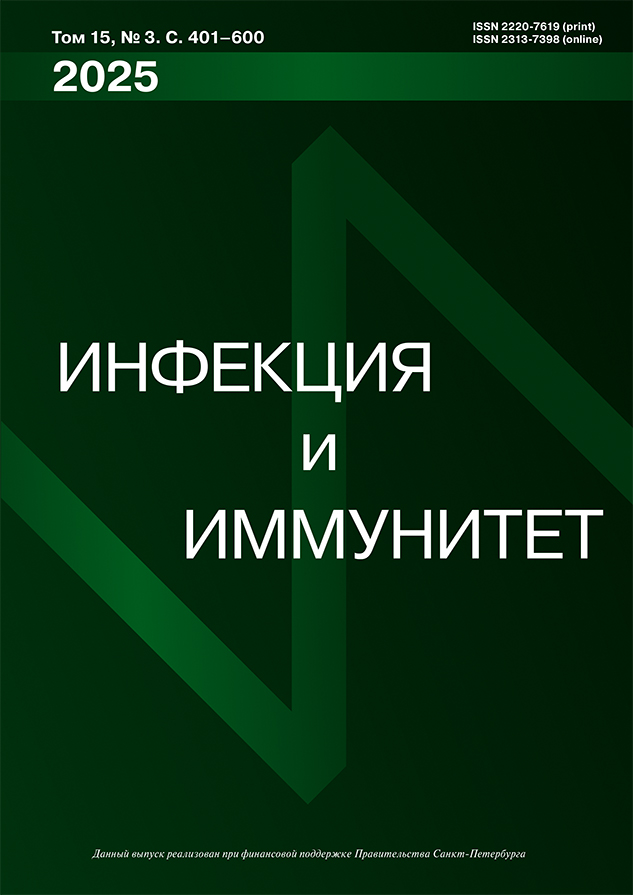SELECTION OF PHYLOGENETICALLY CLOSELY-RELATED YERSINIA PESTIS STRAINS DIFFERING IN THEIR VIRULENCE FOR GUINEA PIGS
- Authors: Anisimov N.V.1, Kombarova T.I.1, Platonov M.E.1, Ivanov S.A.1, Sukhova M.A.1, Dentovskaya S.V.1, Anisimov A.P.1
-
Affiliations:
- State Research Center for Applied Microbiology and Biotechnology, Obolensk, Moscow Region, Russian Federation
- Issue: Vol 5, No 4 (2015)
- Pages: 373-376
- Section: SHORT COMMUNICATIONS
- Submitted: 15.02.2016
- Accepted: 15.02.2016
- Published: 16.12.2015
- URL: https://iimmun.ru/iimm/article/view/354
- DOI: https://doi.org/10.15789/2220-7619-2015-4-373-376
- ID: 354
Cite item
Full Text
Abstract
Genomic, transcriptome or (and) proteomic comparison of closely related virulent and avirulent microbial strains underlies the search for new pathogenicity factors, potential molecular targets for etiotropic therapy, vaccine prevention and immunotherapy of infectious diseases. This investigation was aimed in testing the ability of method of testicular animalization to select phylogenetically close pairs of Y. pestis strains, which dramatically differ in their pathogenicity for guinea pigs, from the populations of as a rule subcutaneously avirulent for guinea pigs “vole” strains of the plague pathogen. Animalization of Y. pestis cultures were performed on guinea pig males by fourfold testicular passage with reducing infective dose. There was no correlation between the ability to cause generalized infectious process (death) after testicular and subcutaneous infection of guinea pigs, but testicular passages made it possible to enrich bacterial culture with a portion of microbes displaying high virulence after subcutaneous infection of this animal species. The methodical approach under study can be successfully applied for selection of pairs of phylogenetically closely related bacterial strains, dramatically differing in their degrees of selective virulence.
About the authors
N. V. Anisimov
State Research Center for Applied Microbiology and Biotechnology, Obolensk, Moscow Region, Russian Federation
Email: fake@neicon.ru
PhD Candidate, Laboratory of Antrax, Department of Especially Dangerous Infectious Diseases, State Research Center for Applied Microbiology and Biotechnology, Obolensk, Moscow Region, Russian Federation
РоссияT. I. Kombarova
State Research Center for Applied Microbiology and Biotechnology, Obolensk, Moscow Region, Russian Federation
Email: fake@neicon.ru
PhD (Biology), Senior Researcher, Laboratory for Biological Testing, State Research Center for Applied Microbiology and Biotechnology, Obolensk, Moscow Region, Russian Federation
РоссияM. E. Platonov
State Research Center for Applied Microbiology and Biotechnology, Obolensk, Moscow Region, Russian Federation
Email: fake@neicon.ru
PhD (Biology), Senior Researcher, Laboratory for Plague Microbiology, Department of Especially Dangerous Infectious Diseases, State Research Center for Applied Microbiology and Biotechnology, Obolensk, Moscow Region, Russian Federation
РоссияS. A. Ivanov
State Research Center for Applied Microbiology and Biotechnology, Obolensk, Moscow Region, Russian Federation
Email: fake@neicon.ru
PhD (Biology), Leading Researcher, Laboratory for Plague Microbiology, Department of Especially Dangerous Infectious Diseases, State Research Center for Applied Microbiology and Biotechnology, Obolensk, Moscow Region, Russian Federation
РоссияM. A. Sukhova
State Research Center for Applied Microbiology and Biotechnology, Obolensk, Moscow Region, Russian Federation
Email: fake@neicon.ru
PhD Candidate, Junior Researcher, Laboratory for Tularemia Microbiology, Department of Especially Dangerous Infectious Diseases, State Research Center for Applied Microbiology and Biotechnology, Obolensk, Moscow Region, Russian Federation
РоссияS. V. Dentovskaya
State Research Center for Applied Microbiology and Biotechnology, Obolensk, Moscow Region, Russian Federation
Email: fake@neicon.ru
PhD, MD (Medicine), Head of Laboratory for Plague Microbiology, State Research Center for Applied Microbiology and Biotechnology, Obolensk, Moscow Region, Russian Federation
РоссияA. P. Anisimov
State Research Center for Applied Microbiology and Biotechnology, Obolensk, Moscow Region, Russian Federation
Author for correspondence.
Email: a-p-anisimov@yandex.ru
PhD, MD (Medicine), Professor, Deputy Director for Science, State Research Center for Applied Microbiology and Biotechnology, Obolensk, Moscow Region, Russian Federation
РоссияReferences
- Гинсбург Н.Н. Живые вакцины. История, элементы теории, практика. М.: Медицина, 1969. С. 304–313. [Ginsburg N.N., Zhivye vaktsiny. Istoriya, elementi teorii, praktika [Live vaccines. History, elements of theory, practice]. Moscow: Meditsina, 1969, pp. 304–313].
- Патент RU № 2510825. Способ получения препарата на основе вакцинного штамма чумного микроба: 2012. Опубл. 10.04.2014, Бюл. № 10. [Patent RU #2510825. Sposob polucheniya preparata na osnove vaktsinnogo shtamma chumnogo mikroba [Method of obtaining preparation based on vaccine strain of plague microbe]: 2012, Publ. 10.04.2014, Bull. no. 10].
- Anisimov A.P., Lindler L.E., Pier G.B. Intraspecific diversity of Yersinia pestis. Clin. Microbiol. Rev., 2004, vol. 17, pp. 434–464.
- Ellison D.W., Clark T.R., Sturdevant D.E., Virtaneva K., Porcella S.F., Hackstadt T. Genomic comparison of virulent Rickettsia rickettsii Sheila Smith and avirulent Rickettsia rickettsii Iowa. Infect. Immun., vol. 76, pp. 542–550.
- Finney D.J. Statistical Method in Biological Assay. 3rd ed. Charles Griffin, London, 1978.
- Johnson T.J., Abrahante J.E., Hunter S.S., Hauglund M., Tatum F.M., Maheswaran S.K., Briggs R.E. Comparative genome analysis of an avirulent and two virulent strains of avian Pasteurella multocida reveals candidate genes involved in fitness and pathogenicity. BMC Microbiol., 2013, vol. 13:106. doi: 10.1186/1471-2180-13-106
- Niikura M., Ono E., Yanagawa R. Molecular comparison of antigens and proteins of virulent and avirulent clones of Leptospira interrogans serovar copenhageni, strain Shibaura. Zentralbl. Bakteriol. Mikrobiol. Hyg. A., 1987, vol. 266, pp. 453–462.
- Perry R.D., Fetherston J.D. Yersinia pestis — etiologic agent of plague. Clin. Microbiol. Rev., 1997, vol. 10, pp. 35–66.
- Platonov M.E., Evseeva V.V., Dentovskaya S.V., Anisimov A.P. Molecular typing of Yersinia pestis. Mol. Gen. Microbiol. Virol., 2013, vol. 28, pp. 41–45.
- Platonov M.E., Evseeva V.V., Svetoch T.E., Efremenko D.V., Kuznetsova I.V., Dentovskaia S.V., Kulichenko A.N., Anisimov A.P. Phylogeography of Yersinia pestis vole strains isolated from natural foci of the Caucasus and South Caucasus. Mol. Gen. Microbiol. Virol., 2012, vol. 27, pp. 108–111.
- Uda A., Sekizuka T., Tanabayashi K., Fujita O., Kuroda M., Hotta A., Sugiura N., Sharma N., Morikawa S., Yamada A. Role of pathogenicity determinant protein C (PdpC) in determining the virulence of the Francisella tularensis subspecies tularensis SCHU. PLOS One, 2014, vol. 9, e89075.
- Zhao S., Zhu W., Xue S., Han D. Testicular defense systems: immune privilege and innate immunity. Cell. Mol. Immunol., 2014, vol. 11, pp. 428–437. doi: 10.1038/cmi.2014.38
Supplementary files







